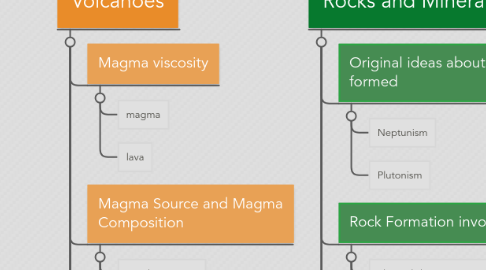
1. Earth in Space
1.1. Old Ideas, New Ideas
1.1.1. Geocentric orbit hypothesis
1.1.2. Heliocentric orbit hypothesis
1.2. Origin of Universe
1.2.1. Size of the Universe
1.2.1.1. Luminosity
1.2.1.2. Doppler Effect
1.2.2. Big Bang Theory
1.2.2.1. cepheid variables
1.3. Stars
1.3.1. white dwarf
1.3.2. black dwarf
1.3.3. red supergiant
1.4. Planets
1.4.1. Jovian
1.4.2. Terrestrial
1.4.2.1. Crust
1.4.2.2. Mantle
1.4.2.3. Core
1.4.3. Dwarf
1.5. Unique Composition of Earth
1.5.1. Crust
1.5.1.1. Lithosphere
1.5.1.2. Asthenosphere
1.5.2. Mantle
1.5.3. Core
1.5.4. Liquid Water
1.5.5. Gravity
1.5.6. Protective atmosphere
1.5.7. Life-sustaining gases
1.5.8. Strong magnetic field
2. Plate Boundaries
3. Plate Tectonics
3.1. Science and Santa Claus
3.1.1. Paradigm
3.1.2. Paradigm Shift
3.2. Major elevation zones
3.2.1. Land and shallows ocean
3.2.2. Deep ocean floor
3.3. Continental Drift
3.3.1. Wegener's Observations
3.3.1.1. Matching features
3.3.1.2. Paleoclimates
3.4. Evidence from the Seafloor
3.4.1. Seafloor topography
3.4.1.1. Continental shelf
3.4.1.2. Abyssal plain
3.4.1.3. Oceanic ridge
3.4.1.4. Oceanic trench
3.4.2. Age of the seafloor
3.4.3. Heat flow
3.4.4. Volcanoes
3.4.5. Earthquakes
3.4.5.1. Deep earthquakes
3.4.5.2. Largest earthquakes
3.5. Seafloor Spreading Hypothesis
3.5.1. Observations & Interpretations
3.5.1.1. Ocean margins without trench
3.5.1.2. Ocean margins with trench
3.5.1.3. Oceanic ridges
3.6. Magnetic Field Reversals
3.6.1. Normal Polarity
3.6.2. Reverse Polarity
3.7. Major Plates
3.7.1. African
3.7.2. Antartic
3.7.3. Eurasian
3.7.4. Indian-Australian
3.7.5. Nazca
3.7.6. North American
3.7.7. Pacific
3.8. 3 changes lead to partial melting
3.8.1. Increasing temperature
3.8.2. Decreasing pressure
3.8.3. Addition of water
3.9. Types of Plate Boundaries
3.9.1. Divergent
3.9.1.1. Birth
3.9.1.2. Youth
3.9.1.3. Maturity
3.9.2. Convergent
3.9.2.1. Ocean/Ocean
3.9.2.2. Ocean/Continent
3.9.2.3. Continent/Continent
3.9.3. Transform
4. Earthquakes
4.1. Fault
4.1.1. focus
4.1.2. epicenter
4.1.3. fault scarp
4.1.4. Types of Fault
4.1.4.1. normal
4.1.4.2. reverse
4.1.4.3. strike-slip
4.1.5. recurrence interval
4.1.6. seismic gap
4.2. Seismic waves
4.2.1. seismograph
4.2.2. seismogram
4.2.3. 2 forms of seismic waves
4.2.3.1. surface waves
4.2.3.1.1. Rayleigh waves
4.2.3.1.2. Loves waves
4.2.3.2. body waves
4.2.3.2.1. P waves
4.2.3.2.2. S waves
4.3. Earthquakes
4.3.1. 2 methods of measuring earthquakes
4.3.1.1. Magnitude
4.3.1.2. Intensity
4.3.1.2.1. Modified Mercalli Scale
4.3.2. Earthquake Hazards
4.3.2.1. Ground Shaking
4.3.2.2. Aftershocks
4.3.2.3. Landslides
4.3.2.4. Elevation Changes
4.3.2.5. Liquefaction
4.3.2.6. Tsunami
5. Volcanoes
5.1. Magma viscosity
5.1.1. magma
5.1.2. lava
5.2. Magma Source and Magma Composition
5.2.1. Basaltic magma
5.2.2. Rhyolitic magma
5.2.3. Andesitic magma
5.3. Measuring the Eruption
5.3.1. Volcanic Explosivity Index
5.4. Products of Volcanic Eruptions
5.4.1. Airborne
5.4.1.1. Tephra
5.4.1.2. Volcanic gases
5.4.2. Flows on land
5.4.2.1. Lava
5.4.2.2. Pyroclastic flow
5.5. Types of Volcanoes
5.5.1. Shield Volcano
5.5.2. Stratovolcano
5.5.3. Cinder cone Volcano
5.6. Other Volcanic Landforms
5.6.1. Caldera
5.6.2. Lava Plateau
5.6.3. Geysers
5.6.4. Hot Springs
5.6.5. Fumeroles
5.6.6. Mud Volcanoes
6. Rocks and Minerals
6.1. Original ideas about how rocks formed
6.1.1. Neptunism
6.1.2. Plutonism
6.2. Rock Formation involves
6.2.1. Physical disintegration of raw materials
6.2.2. Chemical Changes
6.2.3. Thermal effects
6.3. Elements and Atoms: Basic Building Blocks
6.3.1. Atom
6.3.1.1. proton
6.3.1.2. neutron
6.3.1.3. electron
6.3.2. Ions
6.3.3. Bonds that forms minerals
6.3.3.1. Ionic
6.3.3.2. Covalent
6.3.3.3. Multiple
6.4. Minerals
6.4.1. Characteristics
6.4.1.1. Crystal form
6.4.1.2. Cleavage
6.4.1.3. Hardness
6.4.1.4. Color
6.4.1.5. Luster
6.4.1.6. Streak
6.5. Types of Rocks
6.5.1. Igneous
6.5.1.1. Types of Igneous Rocks
6.5.1.1.1. Volcanic Rocks
6.5.1.1.2. Plutonic Rocks
6.5.1.2. 3 Magma Types
6.5.1.2.1. Basaltic Magma
6.5.1.2.2. Andesitic Magma
6.5.1.2.3. Rhyolitic Magma
6.5.2. Sedimentary
6.5.2.1. Types of Sedimentary Rocks
6.5.2.1.1. Clastic
6.5.2.1.2. Chemical
6.5.2.1.3. Biochemical
6.5.3. Metamorphic
6.5.3.1. 2 Types of Metamorphism
6.5.3.1.1. Contact Metamorphism
6.5.3.1.2. Regional Metamorphism
7. Geologic Time
7.1. Major mass extinctions throughout geologic history
7.1.1. Cretaceous-Tertiary (K-T) extinction
7.1.2. Permian-Triassic(P-T) extinction
7.2. Early methods for determining the age of the Earth
7.2.1. Salinity of oceans
7.2.2. Conductive cooling of Earth
8. Weathering and Soils
8.1. Components of the Earth system contained in soil
8.1.1. Geosphere
8.1.2. Hydrosphere
8.1.3. Atmosphere
8.1.4. Biosphere
8.2. Weathering
8.2.1. Physical Weathering
8.2.1.1. Unloading
8.2.1.2. Wedging
8.2.1.2.1. Honeycomb weathering
8.2.2. Chemical Weathering
8.2.2.1. Dissolution
8.2.2.2. Hydrolysis
8.2.2.3. Oxidation
8.2.3. Biological Weathering and Decay
8.2.3.1. Macroscopic
8.2.3.2. Microscopic
8.3. Weathering Rates
8.3.1. Components which control how quickly a rock weathers
8.3.1.1. Rock Composition
8.3.1.2. Rock Properties
8.3.1.3. Climate
8.4. Soil
8.4.1. Soil Profile
8.4.1.1. Organic Activity
8.4.1.2. Leaching and Precipitation
8.4.1.3. Transport of Clays
8.4.2. Soil Erosion is controlled by
8.4.2.1. amount and frequency of rainfall
8.4.2.2. wind velocity
8.4.2.3. character of the soil
8.4.2.4. vegetation cover
8.4.2.5. slope of the land surface
9. Atmosphere
9.1. 4 thermal layers
9.1.1. Troposphere
9.1.2. Stratosphere
9.1.3. Mesosphere
9.1.4. Thermosphere
9.2. Role of Water in the Atmosphere
9.2.1. Humidity
9.2.1.1. Addition of water
9.2.1.2. Decrease in temperature
9.3. Clouds
9.3.1. "cirr"
9.3.2. "alto"
9.3.3. "cumulus"
9.3.4. nimbo or nimbus
9.3.5. stratus
9.4. Fronts
9.4.1. Frontal lifting
9.4.1.1. Orographic lifting
9.4.1.2. Convergence lifting
9.5. Winds
9.5.1. Cyclone
9.5.2. Anti-cyclone

